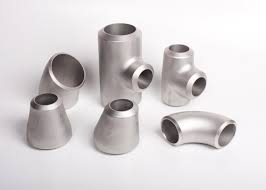Specifications of Stainless Steel Buttweld Fittings
But welding is a procedure used to join the ends of pipes and fittings. Alternatively, it is referred to as welded pipe fittings. It is available with bevelled or plain ends and typically ranges from 3/4″ to 24″.
The uniformity of the fittings is, nevertheless, especially crucial because these fittings are welded into the piping system, and removal of these structures is always difficult. Furthermore, quality concerns with ass welding fittings are magnified because they are welded into the channelling frame.

Types of Stainless Steel Buttweld Fittings:
SS Butt-weld pipe fittings include long elbows, focus reducers, eccentric reducers, and tees. Butt-welded stainless steel is an essential element of the commercial piping systems designed to change direction, split off, or physically connect machinery. Stainless Steel Butt-weld fittings are utilized in nominal piping sizes with a predetermined tube schedule. Butt-weld fitting dimensions and tolerances are established under ASME specification B16.9.
The fitting standard should be outstanding since it would be considered vital to have a relationship between the joints of steel pipe fittings and the piping system.
Industries & Applications:
Stainless Steel Buttweld Fittings are utilized in a wide variety of applications and enterprises. Several of them are listed below:
- Petroleum and gas industries
- The Gas Processing Industry
- Industries involved in food processing
- Petrochemicals
- Chemical Industries
- Industries Concerned with Power Generation
- Sugar Processing
- Fertilizers
How to Select High-Quality Butt Weld Pipe Fittings:
- When testing the SS fittings, it is essential to check the dimensions, including the diameters and, most importantly, the specifications, because the endpoints of the SS butt welding fittings will frequently adapt to the ends of the pipelines. It indicates that the diameters are the same; as otherwise, they cannot correctly bind and cause leakage. A high degree of dimension tolerance is required to enforce consistency with fittings quality inspection in standard steel pipe fittings. Additionally, while selecting butt weld fittings make sure that they are inspected.
- If you are concerned about the quality of these fittings, it is critical to conduct a surface inspection in addition to the dimension inspection. Typically, the uniformity of the surface is visually inspected to determine whether the fittings are rigid and solid. You can immediately determine the manufacturing time of the surface of the fitting, whether the surface of the fitting is new or existing stock, and so on. You will also assess the raw material’s consistency or smoothness.
- Technological expertise is also required for quality control. It enables you to easily access standard details, relevant knowledge, and compliance assessment. Now you can swiftly evaluate if the fittings are compatible with your project.
- Those are the most significant aspects that have received the most attention thus far. It is critical to specify the correct butt weld fittings when purchasing. Steel pipe fittings are vital to the piping system, acting as the piping system’s attaching joints, and the quality must be excellent. Their uniformity is even more critical for butt welding pipe fittings since they are welded into the piping network, and mounting and removing them is difficult.
- Selecting the Buttweld It is critical to select a fitting that has been thoroughly evaluated and tested and gives enhanced functioning. The SS fittings have been tested and manufactured under applicable national and international standards and specifications. Additionally, these tips will assist you in quickly identifying the correct butt weld pipe fittings for the pipeline system and other activities.
Applications of SS Buttweld Fittings:
- Changing Directions – Butt Weld Elbows can join two pipes of various nominal sizes and bend them at 45° or 90°.
- To Make Branches – Butt Weld Tees can connect three different pipes to create a junction. It is frequently referred to as a “three-way fitting.” It is shaped like an alphabet “T,” with two inlets and a single outlet.
- Blocking Pipeline – Butt Weld Caps are used to join and seal the pipeline’s end. We refer to them as Pipe Caps and End Caps.
- To Reduce the Dimensions of the Pipe – Butt Weld Reducers are used to connect pipes of varying diameters.
- Using Flanges – To create flanged connections, lap joint stub ends are used in conjunction with a lap joint flange.




Very Good. Informative